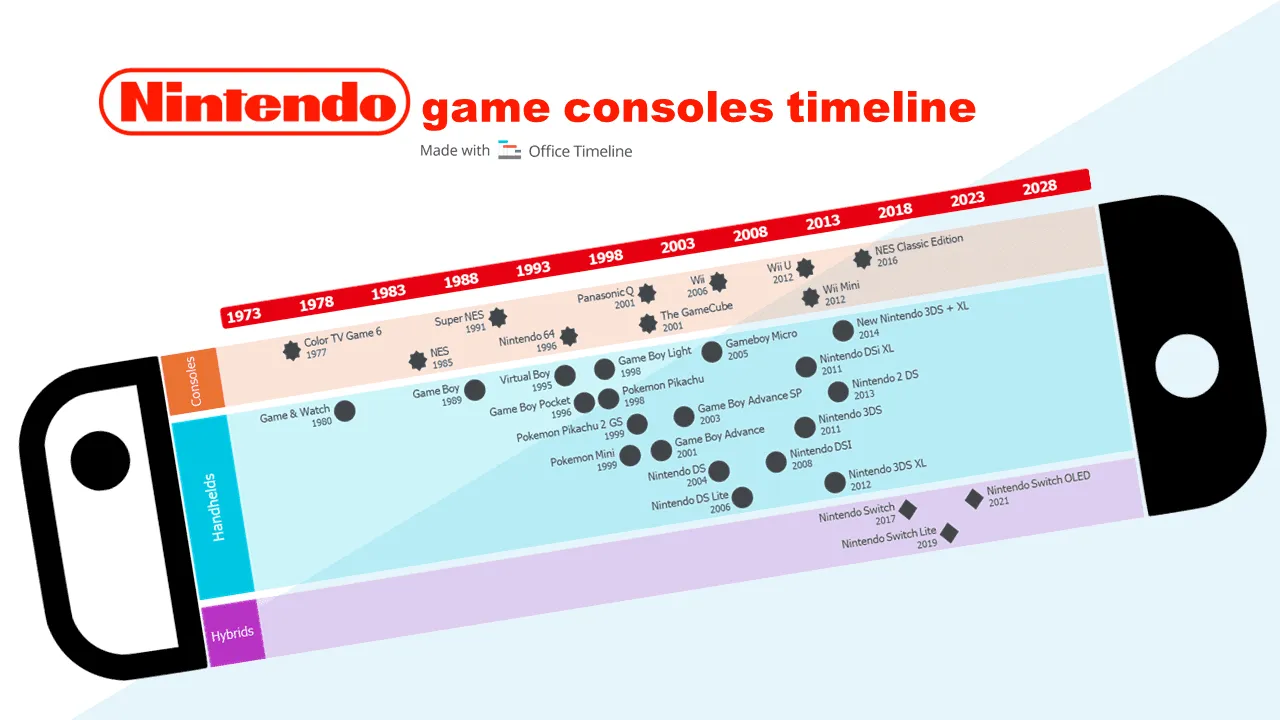Nintendo game consoles timeline
Embark on a captivating journey into gaming history and dive into the evolution of iconic devices with the Nintendo game consoles timeline.
Last updated on April 8, 2024
Take a stroll down memory lane and into the future of gaming with our Nintendo consoles timeline, a visual representation of the evolution of devices from the company that brought us Mario, The Legend of Zelda, Pokémon, Donkey Kong and many other incredibly popular franchises.
Built with Office Timeline, our PowerPoint add-in that so intuitive even Luigi could use it, the chronology celebrates the major milestones of the gaming industry giant. In the words of the iconic moustachioed plumber with a knack for heroics, “Let’s-a go!”.
Nintendo: key milestones
- June 1, 1977: Color TV Game 6
- April 28, 1980: Game & Watch
- October 18, 1985: NES
- April 21, 1989: Game Boy
- August 23, 1991: Super NES
- July 21, 1995: Virtual Boy
- March 23, 1996: Nintendo 64
- July 21, 1996: Game Boy Pocket
- March 27, 1998: Pokémon Pikachu
- April 14, 1998: Game Boy Light
- January 22, 1999: Pokémon Mini
- November 21, 1999: Pokémon Pikachu 2 GS
- March 21, 2001: Game Boy Advance
- September 14, 2001: The GameCube
- December 13, 2001: Panasonic Q
- February 14, 2003: Game Boy Advance SP
- November 21, 2004: Nintendo DS
- September 13, 2005: Gameboy Micro
- March 2, 2006: Nintendo DS Lite
- November 19, 2006: Wii
- November 1, 2008: Nintendo DSI
- February 26, 2011: Nintendo 3DS
- November 21, 2011: Nintendo DSi XL
- July 28, 2012: Nintendo 3DS XL
- November 18, 2012: Wii U
- December 7, 2012: Wii Mini
- October 12, 2013: Nintendo 2 DS
- October 11, 2014: New Nintendo 3DS + XL
- November 10, 2016: NES Classic Edition
- March 3, 2017: Nintendo Switch
- September 20, 2019: Nintendo Switch Lite
- October 8, 2021: Nintendo Switch OLED
Nintendo origins
With billions of video games sales and hundreds of millions of consoles in households worldwide, Nintendo is a company that requires little introduction. In fact, when the Super Mario Bros. game was released, the titular characters were on par with, or even more popular among children than Disney’s Mickey Mouse or Warner Bros.’ Bugs Bunny. But how did it all start? Grab your ocarinas and let’s play the “Song of Time”.
The very first games created by Fusajiro Yamauchi, the founder of the company, back in 1889 (you read that right) were sets of flower-themed Japanese playing cards called Hanafuda. In 1902, he began designing western-type playing cards. While these versions were initially meant exclusively for export, they quickly gained popularity in Japan as well. About 31 years later, the company named Yamauchi Nintendo & Co was born.
Playing cards were their bread and butter up to 1963, when the company was rebranded as Nintendo Co., Ltd., marking their debut in game manufacturing. The product that marked Nintendo’s debut in electronic games was the “Beam Gun” series (later renamed “The Zapper”), released in 1973. It’s worth noting that the introduction of opto-electronic technology (which allowed players to aim and shoot targets on a screen using light beam guns) was a premiere in Japan.
Nintendo rises
A couple of things are worth mentioning here, for context: during the late ‘70s and early ‘80s, the gaming industry was rolling into the mainstream market, with Atari, Nintendo and Sega at the forefront. The astonishing potential for profit of arcade and console games determined Atari execs to make some bad calls, like releasing subpar versions of games as fast as possible.
In turn, this triggered a plummeting in sales for Atari, but helped Nintendo emerge as the dominant powerhouse in gaming. By 1987, Nintendo owned 65% of the video game hardware market, while Atari’s share dropped from 80% to a measly 24%.
Introducing their first home gaming console, the Nintendo Entertainment System or NES, for short, in the US during the mid ‘80s turned out to be an extremely lucrative decision. By ’89, they controlled 95% of the console sector. Unfortunately, by this point SEGA with their Genesis console were already aggressively muscling in on Nintendo’s territory. As a response, the latter introduced the SNES (Super Nintendo Entertainment System) and the Game Boy, in an attempt to offset Sega’s growing industry dominance.
Nintendo declines
Nintendo began to slowly but surely lose ground to competitors (Sega, Sony PlayStation, etc.) during the mid ‘90s. The rising popularity of home computers that started back in the ’82 with the introduction of the Commodore 64 certainly didn’t help either. During the early 2000s, Nintendo launched the GameCube, a console that failed to become a serious competitor for the Xbox or PlayStation 2.
Things took a turn for the worse when Microsoft launched the Xbox Live, introducing online gaming capabilities in the console industry. Nintendo’s troubles were further exacerbated by the surge of computer-based MMOs (Massive Multiplayer Online), spearheaded by World of Warcraft.
The Nintendo Wii released in 2006 helped the Japanese game maker recover some ground, in part thanks to major names like Mario Kart and Wii Sports. Its success was pretty short lived, as the following version – Wii U – turned out to be a commercial disaster.
Throughout the 2000s, phone-based games established a solid foothold in an already crowded industry. For Nintendo, this originally represented a setback. However, when Pokémon Go was launched by Niantic, Nintendo’s leadership made strategic investments in the venture. The instant success of the app was a lifeline for the struggling console maker.
Nintendo bounces back (but not very high)
In 2017, things started looking up, as the release of the innovative Nintendo Switch hybrid console proved an instant success. Flexibility was the device’s main selling point: it doubled both as a home console and a portable handheld. Switch sales rose to over 120 million, nearly achieving the same commercial success as the highest selling gaming consoles like PlayStation 2 (158 million) or Nintendo DS (154 million).
Even so, Nintendo’s popularity in the gaming console industry is still a far cry from its glory days. PlayStation owns over 85% of the market share, while Xbox holds 14%, so Nintendo’s 0.05% is basically table scraps. That said, everyone’s anxiously waiting for the Switch 2 to drop. Rumour has it that it will be heavily focused on VR, using a proprietary system known as Nintendo Labo VR.
Frequently asked questions about Nintendo consoles
Let’s try to answer some of the most frequently asked questions about Nintendo and their devices.
You might be quick to assume that Nintendo started out as a video game and console manufacturer, but the company traces its origins to the 19th century, or more specifically 1889, when electronics were nothing but a distant dream. Founded by Fusajiro Yamauchi, the company began its journey by crafting Hanafuda, a type of Japanese playing cards. Their very first electronic toy, the “Beam Gun”, was an opto-electronic controller shaped like a pistol; it was released in the ‘70s.
While they are definitely not able to stand toe to toe with giants like Microsoft’s Xbox or Sony’s PlayStation, Nintendo is still a notable player in the gaming industry. The bulk of their income is generated from video game platform sales and mobile games. The number of Switch units purchased rival its PlayStation 5 and Xbox competitors, while timeless series like Mario, The Legend of Zelda, Super Smash Bros, Animal Crossing, Splatoon, etc. still help drive sales. Furthermore, while their revenue in 2023 was almost half of Sony’s and slightly less than Microsoft’s, Nintendo was still the #1 console maker in terms of profitability, with a 30% profit margin across the whole year.
The name of this Japanese console maker is shrouded in mystery, and has two possible interpretations:
- “Leave luck to heaven” – this translation, while appealing in the context of video games because it emphasizes the importance of player skills versus providence, doesn’t really have historical validation.
- “The temple of free hanafuda” – an alternate translation that references the Japanese hanafuda playing cards, which were the very first products sold by the company since 1889.
It’s worth noting that the popularity of the devices as well as the longevity of the company have earned Nintendo a place in the Collins dictionary.
Nintendo has established a number of incredibly popular franchises over the years. Naturally, there is some debate on what the absolute best games are. Some of the most popular titles available on the Nintendo Switch you can’t go wrong with include:
- Mario Kart 8 Deluxe
- Animal Crossing: New Horizons
- Super Smash Bros. Ultimate
- The Legend of Zelda: Breath of the Wild
- Super Mario Odyssey
- Pokémon Sword / Pokémon Shield
- Pokémon Scarlet / Pokémon Violet
- Super Mario Party
- Legend of Zelda: Tears of the Kingdom
- New Super Mario Bros. U Deluxe
We’ve based our hierarchy on the number of copies sold globally before December 31, 2023.
By popular vote, the Virtual Boy seems to be the absolute worst performing product released by Nintendo. What was it? An attempt to make virtual reality tech a thing during the ‘90s that we’d really love to give them credit for. Unfortunately, the technological limitations of the decade paired with the steep price range and disastrous decisions ultimately led to very few people owning a Virtual Boy, and even fewer enjoying it.
About the Nintendo game consoles timeline
The Nintendo game consoles timeline was built in Office Timeline, a powerful and intuitive add-in for PowerPoint that can help you design amazing visuals for your presentations. Download the free trial version today and learn what it can do first hand.
Eddy is Co-Founder & Chief Product Officer for Office Timeline, building a user-friendly but powerful app that makes timelines, Gantt charts and roadmaps directly in PowerPoint.
Turn project data into professional timelines
Get the advanced features of Office Timeline free for 14 days.



